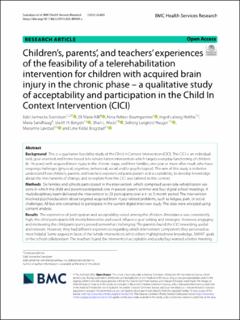| dc.description.abstract | Background This is a qualitative feasibility study of the Child in Context Intervention (CICI). The CICI is an individual‐ ized, goal‐oriented and home‐based tele‐rehabilitation intervention which targets everyday functioning of children (6–16 years) with acquired brain injury in the chronic stage, and their families, one year or more after insult, who have ongoing challenges (physical, cognitive, behavioral, social and/or psychological). The aim of this study is to better understand how children, parents and teachers experienced participation and acceptability; to develop knowledge about the mechanisms of change, and to explore how the CICI was tailored to the context.
Methods Six families and schools participated in the intervention, which comprised seven tele‐rehabilitation ses‐ sions in which the child and parent participated, one in‐person parent seminar and four digital school meetings. A multidisciplinary team delivered the intervention to 23 participants over a 4‐ to 5‐month period. The intervention involved psychoeducation about targeted acquired brain injury‐related problems, such as fatigue, pain, or social challenges. All but one consented to participate in the current digital interview study. The data were analyzed using content analysis.
Results The experience of participation and acceptability varied among the children. Attendance was consistently high; the child participants felt mostly listened to and could influence goal setting and strategies. However, engaging and motivating the child participants proved somewhat challenging. The parents found the CICI rewarding, useful and relevant. However, they had different experiences regarding which intervention component they perceived as most helpful. Some argued in favor of the ‘whole intervention’, while others highlighted new knowledge, SMART goals or the school collaboration. The teachers found the intervention acceptable and useful but wanted a better meeting plan. They had difficulties in finding time for meetings, emphasized the involvement of school leaders, and appreci‐ ated the digital format.
Conclusions Overall, the intervention was perceived as acceptable, and the participants felt that the various inter‐ vention components contributed to improvements. The CICI’s flexibility facilitated tailoring to different contexts based on the children’s functional level. The digital format saved time and provided flexibility regarding the amount of attendance but limited full participation from children with more severe cognitive impairments. | en_US |

